3.3 Vector Addition and Subtraction: Analytical Methods
Learning Objectives
By the end of this section, you will be able to:
- Understand the rules of vector addition and subtraction using analytical methods.
- Apply analytical methods to determine vertical and horizontal component vectors.
- Apply analytical methods to determine the magnitude and direction of a resultant vector.
Analytical methods of vector addition and subtraction employ geometry and simple trigonometry rather than the ruler and protractor of graphical methods. Part of the graphical technique is retained, because vectors are still represented by arrows for easy visualization. However, analytical methods are more concise, accurate, and precise than graphical methods, which are limited by the accuracy with which a drawing can be made. Analytical methods are limited only by the accuracy and precision with which physical quantities are known.
Resolving a Vector into Perpendicular Components
Analytical techniques and right triangles go hand-in-hand in physics because (among other things) motions along perpendicular directions are independent. We very often need to separate a vector into perpendicular components. For example, given a vector like [latex]\mathbf{A}[/latex] in Figure 3.24, we may wish to find which two perpendicular vectors, [latex]\mathbf{A}_{x}[/latex] and [latex]\mathbf{A}_{y}[/latex], add to produce it.
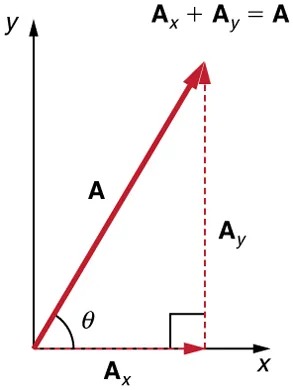
Figure 3.24 The vector [latex]\mathbf{A}[/latex], with its tail at the origin of an x, y-coordinate system, is shown together with its x– and y-components, [latex]\mathbf{A}_{x}[/latex] and [latex]\mathbf{A}_{y}[/latex]. These vectors form a right triangle. The analytical relationships among these vectors are summarized below. Image from OpenStax College Physics 2e, CC-BY 4.0
Image Description
The image depicts a vector diagram on a Cartesian coordinate system. There is a right triangle formed by two components and the resultant vector:
- A represents the resultant vector, shown as a red arrow at an angle. The vector A is positioned from the origin and extends into the first quadrant.
- The vector has a magnitude labeled as A.
- The horizontal component, Ax, is shown as a dashed red line extending along the x-axis.
- The vertical component, Ay, is shown as a dashed red line extending parallel to the y-axis.
- An angle θ (theta) is formed between the x-axis and the vector A.
- A right angle is marked between Ax and Ay using a small square.
- Text at the top of the image states: Ax + Ay = A
- Both x and y axes are labeled accordingly.
[latex]\mathbf{A}_{x}[/latex] and [latex]\mathbf{A}_{y}[/latex] are defined to be the components of [latex]\mathbf{A}[/latex] along the x– and y-axes. The three vectors [latex]\mathbf{A}[/latex], [latex]\mathbf{A}_{x}[/latex], and [latex]\mathbf{A}_{y}[/latex] form a right triangle:
[latex]\mathbf{A}_{x} \textrm{ }+\textrm{ }\text{A}_{y} \textrm{ }=\textrm{ }\text{A} .[/latex]
Note that this relationship between vector components and the resultant vector holds only for vector quantities (which include both magnitude and direction). The relationship does not apply for the magnitudes alone. For example, if [latex]\textbf{A}_{x} = 3 m[/latex] east, [latex]\textbf{A}_{y} = 4 m[/latex] north, and [latex]\textbf{A} = 5 m[/latex] north-east, then it is true that the vectors [latex]\mathbf{A}_{x} \textrm{ }+\textrm{ }\text{A}_{y} \textrm{ }=\textrm{ }\text{A}[/latex]. However, it is not true that the sum of the magnitudes of the vectors is also equal. That is,
[latex]\text{3 m} + \text{4 m}\textrm{ } \neq \textrm{ }\text{5 m} \\[/latex]
Thus,
[latex]A_{x} + A_{y} \neq A[/latex]
If the vector [latex]\mathbf{A}[/latex] is known, then its magnitude [latex]A[/latex] (its length) and its angle [latex]\theta[/latex] (its direction) are known. To find [latex]A_{x}[/latex] and [latex]A_{y}[/latex], its x– and y-components, we use the following relationships for a right triangle.
[latex]A_{x} = A \text{cos} \theta[/latex]
and
[latex]A_{y} = A \text{sin} \theta .[/latex]
![]A dotted vector A sub x whose magnitude is equal to A cosine theta is drawn from the origin along the x axis. From the head of the vector A sub x another vector A sub y whose magnitude is equal to A sine theta is drawn in the upward direction. Their resultant vector A is drawn from the tail of the vector A sub x to the head of the vector A-y at an angle theta from the x axis. Therefore vector A is the sum of the vectors A sub x and A sub y.](https://ecampusontario.pressbooks.pub/app/uploads/sites/6296/2025/08/3a1c74dc5a129ac01976d7f3c4914d6055c4e578.jpg)
Figure 3.25 The magnitudes of the vector components [latex]\mathbf{A}_{x}[/latex] and [latex]\mathbf{A}_{y}[/latex] can be related to the resultant vector [latex]\mathbf{A}[/latex] and the angle [latex]\theta[/latex] with trigonometric identities. Here we see that [latex]A_{x} = A \text{cos} \theta[/latex] and [latex]A_{y} = A \text{sin} \theta[/latex]. Image from OpenStax College Physics 2e, CC-BY 4.0
Image Description
The image is a diagram illustrating vector decomposition in a two-dimensional coordinate system. It shows:
– A two-dimensional Cartesian plane with an x-axis and y-axis.
– A vector A represented by a red arrow pointing diagonally from the origin, creating an angle **θ** with the positive x-axis.
– The vector A is decomposed into two components:
– Ax, lying along the x-axis, calculated as **Acosθ**.
– Ay, lying along the y-axis, calculated as **Asinθ**.
– A dashed line alongside **Ay**, perpendicular to the x-axis, emphasizes the right triangle formed by **A**, **Ax**, and **Ay**.
– There is a mathematical expression at the top: **Ax + Ay = A**, indicating the composition of vector **A** from its components.
Suppose, for example, that [latex]\mathbf{A}[/latex] is the vector representing the total displacement of the person walking in a city considered in 3.1 Kinematics in Two Dimensions: An Introduction and 3.2 Vector Addition and Subtraction: Graphical Methods.
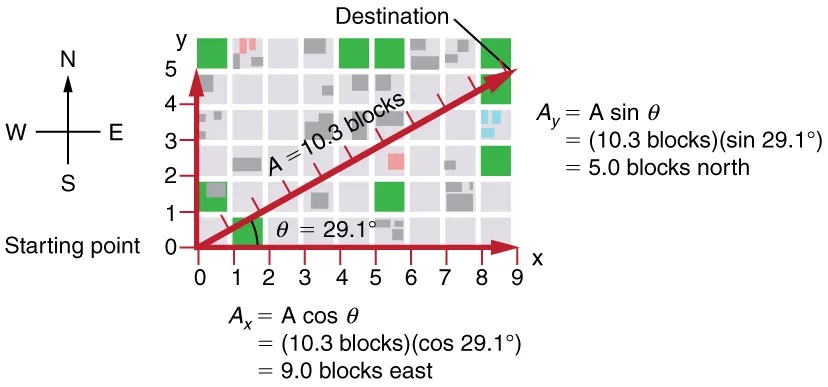
Figure 3.26 We can use the relationships [latex]A_{x} = A \text{cos} \theta[/latex] and [latex]A_{y} = A \text{sin} \theta[/latex] to determine the magnitude of the horizontal and vertical component vectors in this example. Image from OpenStax College Physics 2e, CC-BY 4.0
Image Description
The image is a diagram illustrating the components of a vector on a grid map. It includes the following elements:
- A compass rose in the top left corner pointing to the cardinal directions: North (N) is upwards, East (E) is to the right, South (S) is downwards, and West (W) is to the left. The label “Starting point” is near this compass.
- A grid is displayed on the main part of the image, representing city blocks. Each block is a square, some of which are colored green or gray, indicating different types of locations or obstacles.
- The x-axis runs horizontally along the bottom from 0 to 9, and the y-axis runs vertically along the left side from 0 to 5. Both axes have red arrows indicating their directions, with the x-axis pointing east and the y-axis pointing north.
- A red vector arrow extends from the starting point at the origin (0,0) to a destination at (8,5). This vector is labeled as A = 10.3 blocks and forms an angle θ = 29.1° with the x-axis.
- The vector is decomposed into horizontal and vertical components:
- The horizontal component, Ax, is calculated as:
- Ax = A cos θ
- (10.3 blocks)(cos 29.1°)
- = 9.0 blocks east
- The vertical component, Ay, is calculated as:
- Ay = A sin θ
- (10.3 blocks)(sin 29.1°)
- = 5.0 blocks north
- The horizontal component, Ax, is calculated as:
Then [latex]A = 10.3[/latex] blocks and [latex]\theta = 29.1º[/latex], so that
[latex]A_{x} = A \text{cos} \theta = \left(\right. \text{10}.\text{3 blocks} \left.\right) \left(\right. \text{cos} 29.1º \left.\right) = \text{9}.\text{0 blocks}[/latex]
[latex]A_{y} = A \text{sin} \theta = \left(\right. \text{10}.\text{3 blocks} \left.\right) \left(\right. \text{sin} 29.1º \left.\right) = \text{5}.\text{0 blocks} .[/latex]
Calculating a Resultant Vector
If the perpendicular components [latex]\mathbf{A}_{x}[/latex] and [latex]\mathbf{A}_{y}[/latex] of a vector [latex]\mathbf{A}[/latex] are known, then [latex]\mathbf{A}[/latex] can also be found analytically. To find the magnitude [latex]A[/latex] and direction [latex]\theta[/latex] of a vector from its perpendicular components [latex]\mathbf{A}_{x}[/latex] and [latex]\mathbf{A}_{y}[/latex], relative to the x-axis, we use the following relationships:
[latex]A = \sqrt{A_{x} ^{2} + A_{y} ^{2}}[/latex]
[latex]\theta = \text{tan}^{- 1} \left(\right. A_{y} / A_{x} \left.\right) .[/latex]
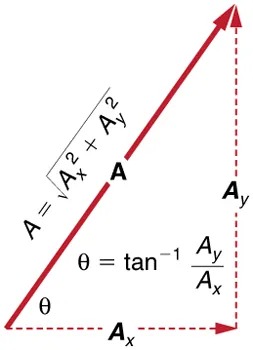
Figure 3.27 The magnitude and direction of the resultant vector can be determined once the horizontal and vertical components [latex]A_{x}[/latex] and [latex]A_{y}[/latex] have been determined. Image from OpenStax College Physics 2e, CC-BY 4.0
Image Description
The image is a diagram of a vector represented in a two-dimensional coordinate system. The vector is shown as a red arrow pointing diagonally upwards and to the right. Here’s a breakdown of the image:
– The vector is labeled as “A” and is drawn from the origin to an endpoint, creating a triangle with the horizontal and vertical components.
– The horizontal component of the vector, labeled as “Ax“, is represented by a dashed red arrow along the x-axis.
– The vertical component, labeled as “Ay“, is represented by a dashed red arrow along the y-axis.
– An angle θ (theta) is shown between the horizontal component and the vector, indicating the direction of the vector.
– There are two mathematical equations:
– The magnitude of the vector is given by: A = √(Ax2 + Ay2).
– The angle θ is given by: θ = tan-1(Ay/Ax).
The image is designed to illustrate how the magnitude and direction of vector A can be determined using its components.
Note that the equation [latex]A = \sqrt{A_{x}^{2} + A_{y}^{2}}[/latex] is just the Pythagorean theorem relating the legs of a right triangle to the length of the hypotenuse. For example, if [latex]A_{x}[/latex] and [latex]A_{y}[/latex] are 9 and 5 blocks, respectively, then [latex]A = \sqrt{9^{2} +\text{5}^{2}} =\text{10} . 3[/latex] blocks, again consistent with the example of the person walking in a city. Finally, the direction is [latex]\theta = \text{tan}^{–1} \left(\right. \text{5}/\text{9} \left.\right) =29.1º[/latex], as before.
Determining Vectors and Vector Components with Analytical Methods
Equations [latex]A_{x} = A \text{cos} \theta[/latex] and [latex]A_{y} = A \text{sin} \theta[/latex] are used to find the perpendicular components of a vector—that is, to go from [latex]A[/latex] and [latex]\theta[/latex] to [latex]A_{x}[/latex] and [latex]A_{y}[/latex]. Equations [latex]A = \sqrt{A_{x}^{2} + A_{y}^{2}}[/latex] and [latex]\theta = \text{tan}^{–\text{1}} \left(\right. A_{y} / A_{x} \left.\right)[/latex] are used to find a vector from its perpendicular components—that is, to go from [latex]A_{x}[/latex] and [latex]A_{y}[/latex] to [latex]A[/latex] and [latex]\theta[/latex]. Both processes are crucial to analytical methods of vector addition and subtraction.
Adding Vectors Using Analytical Methods
To see how to add vectors using perpendicular components, consider Figure 3.28, in which the vectors [latex]\mathbf{A}[/latex] and [latex]\mathbf{B}[/latex] are added to produce the resultant [latex]\mathbf{R}[/latex].
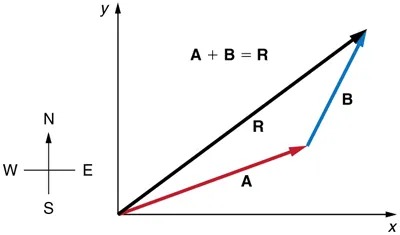
Figure 3.28 Vectors [latex]\mathbf{A}[/latex] and [latex]\mathbf{B}[/latex] are two legs of a walk, and [latex]\mathbf{R}[/latex] is the resultant or total displacement. You can use analytical methods to determine the magnitude and direction of [latex]\mathbf{R}[/latex]. Image from OpenStax College Physics 2e, CC-BY 4.0
Image Description
The image contains a diagram illustrating vector addition on a two-dimensional coordinate system, with an x-axis and a y-axis.
– On the right side, the diagram shows three arrows representing vectors.
– Vector A is depicted as a red arrow starting from the origin (0,0) and pointing towards the positive x-axis.
– Vector B is depicted as a blue arrow that starts at the head of Vector A and points diagonally upwards towards the positive y-axis.
– Resultant Vector R is shown as a black arrow starting from the origin and ending at the head of Vector B, representing the vector sum of A and B (A + B = R).
– The x-axis is horizontal, pointing right, and the y-axis is vertical, pointing upwards.
– On the left side of the image, there is a compass rose indicating the cardinal directions, with ‘N’ at the top for north, ‘S’ at the bottom for south, ‘E’ on the right for east, and ‘W’ on the left for west.
If [latex]\mathbf{A}[/latex] and [latex]\mathbf{B}[/latex] represent two legs of a walk (two displacements), then [latex]\mathbf{R}[/latex] is the total displacement. The person taking the walk ends up at the tip of [latex]\mathbf{R} .[/latex] There are many ways to arrive at the same point. In particular, the person could have walked first in the x-direction and then in the y-direction. Those paths are the x– and y-components of the resultant, [latex]\mathbf{R}_{x}[/latex] and [latex]\mathbf{R}_{y}[/latex]. If we know [latex]\textbf{R}_{x}[/latex] and [latex]\mathbf{R}_{y}[/latex], we can find [latex]R[/latex] and [latex]\theta[/latex] using the equations [latex]A = \sqrt{\left(A_{x}\right)^{2} + \left(A_{y}\right)^{2}}[/latex] and [latex]\theta = \text{tan}^{–1} \left(\right. A_{y} / A_{x} \left.\right)[/latex]. When you use the analytical method of vector addition, you can determine the components or the magnitude and direction of a vector.
Step 1. Identify the x- and y-axes that will be used in the problem. Then, find the components of each vector to be added along the chosen perpendicular axes. Use the equations [latex]A_{x} = A \text{cos} \theta[/latex] and [latex]A_{y} = A \text{sin} \theta[/latex] to find the components. In Figure 3.29, these components are [latex]A_{x}[/latex], [latex]A_{y}[/latex], [latex]B_{x}[/latex], and [latex]B_{y}[/latex]. The angles that vectors [latex]\mathbf{A}[/latex] and [latex]\mathbf{B}[/latex] make with the x-axis are [latex]\theta_{\text{A}}[/latex] and [latex]\theta_{\text{B}}[/latex], respectively.
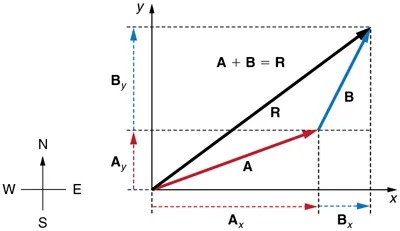
Figure 3.29 To add vectors [latex]\mathbf{A}[/latex] and [latex]\mathbf{B}[/latex], first determine the horizontal and vertical components of each vector. These are the dotted vectors [latex]\mathbf{A}_{x}[/latex], [latex]\mathbf{A}_{y}[/latex], [latex]\mathbf{B}_{x}[/latex] and [latex]\textbf{B}_{y}[/latex] shown in the image. Image from OpenStax College Physics 2e, CC-BY 4.0
Image Description
The image illustrates a vector addition diagram on a coordinate plane.
The diagram consists of three vectors labeled as A, B, and R, where A + B = R. All vectors are positioned on an x–y coordinate system.
- A is drawn as a red arrow originating from the origin (0,0) and points in a diagonal direction. Its horizontal component is labeled as Ax and the vertical component as Ay.
- B is a blue arrow originating from the endpoint of vector A and also forms a diagonal. Its components are labeled similarly as Bx and By.
- R is a black arrow representing the resultant vector, stretching from the origin to the endpoint of vector B and is in a diagonal orientation.
Dashed lines are present to show the components of each vector along the x and y axes.
To the left of the coordinate system, there is a compass rose indicating directions: North (N), South (S), East (E), and West (W).
Step 2. Find the components of the resultant along each axis by adding the components of the individual vectors along that axis. That is, as shown in Figure 3.30,
[latex]R_{x} = A_{x} + B_{x}[/latex]
and
[latex]R_{y} = A_{y} + B_{y} .[/latex]
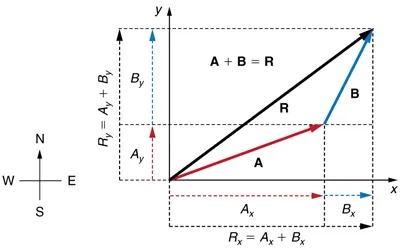
Figure 3.30 The magnitude of the vectors [latex]\mathbf{A}_{x}[/latex] and [latex]\mathbf{B}_{x}[/latex] add to give the magnitude [latex]R_{x}[/latex] of the resultant vector in the horizontal direction. Similarly, the magnitudes of the vectors [latex]\mathbf{A}_{y}[/latex] and [latex]\mathbf{B}_{y}[/latex] add to give the magnitude [latex]R_{y}[/latex] of the resultant vector in the vertical direction. Image from OpenStax College Physics 2e, CC-BY 4.0
Image Description
The image illustrates a vector addition diagram on a Cartesian coordinate system. It features two vectors, A and B, represented as arrows, and their resultant vector, R, also shown as an arrow. The vector A is drawn in red, vector B in blue, and the resultant vector R in black.
The vectors are positioned such that they follow the rule for vector addition (head-to-tail method), where the tail of vector B is at the head of vector A. The resultant vector R is drawn from the tail of A to the head of B.
The diagram includes the horizontal and vertical components of each vector, as follows:
- Ax and Ay are the horizontal and vertical components of vector A.
- Bx and By are the horizontal and vertical components of vector B.
- Rx and Ry are the horizontal and vertical components of the resultant vector R.
Equations shown in the diagram:
- A + B = R, indicating the vector addition.
- Rx = Ax + Bx
- Ry = Ay + By
To the left of the vector addition diagram is a compass indicating directions with labels: N (North), S (South), E (East), and W (West).
Components along the same axis, say the x-axis, are vectors along the same line and, thus, can be added to one another like ordinary numbers. The same is true for components along the y-axis. (For example, a 9-block eastward walk could be taken in two legs, the first 3 blocks east and the second 6 blocks east, for a total of 9, because they are along the same direction.) So resolving vectors into components along common axes makes it easier to add them. Now that the components of [latex]\mathbf{R}[/latex] are known, its magnitude and direction can be found.
Step 3. To get the magnitude [latex]R[/latex] of the resultant, use the Pythagorean theorem:
[latex]R = \sqrt{R_{x}^{2} + R_{y}^{2}} .[/latex]
Step 4. To get the direction of the resultant relative to the x-axis:
[latex]\theta = \text{tan}^{- 1} \left(\right. R_{y} / R_{x} \left.\right) .[/latex]
The following example illustrates this technique for adding vectors using perpendicular components.
Example 3.3
Adding Vectors Using Analytical Methods
Add the vector [latex]\mathbf{A}[/latex] to the vector [latex]\mathbf{B}[/latex] shown in Figure 3.31, using perpendicular components along the x– and y-axes. The x– and y-axes are along the east–west and north–south directions, respectively. Vector [latex]\mathbf{A}[/latex] represents the first leg of a walk in which a person walks [latex]\text{53} . \text{0 m}[/latex] in a direction [latex]\text{20} . 0 º[/latex] north of east. Vector [latex]\mathbf{B}[/latex] represents the second leg, a displacement of [latex]\text{34} . \text{0 m}[/latex] in a direction [latex]\text{63} . 0 º[/latex] north of east.
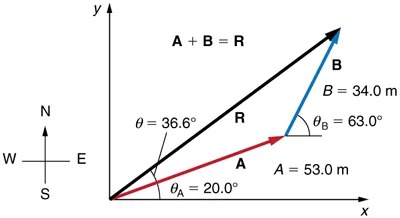
Figure 3.31 Vector [latex]\mathbf{A}[/latex] has magnitude [latex]\text{53} . \text{0 m}[/latex] and direction [latex]\text{20} . 0 º[/latex] north of the x-axis. Vector [latex]\mathbf{B}[/latex] has magnitude [latex]\text{34} . \text{0 m}[/latex] and direction [latex]\text{63} . 0 º[/latex] north of the x-axis. You can use analytical methods to determine the magnitude and direction of [latex]\mathbf{R}[/latex]. Image from OpenStax College Physics 2e, CC-BY 4.0
Image Description
The image shows a vector diagram on an x-y coordinate system illustrating the addition of two vectors, A and B, resulting in a resultant vector R. Here is a detailed description:
- The x-axis is horizontal, and the y-axis is vertical, forming a right-angle coordinate system.
- Vector A is represented by a red arrow, pointing at an angle of 20.0° above the positive x-axis, with a magnitude of 53.0 meters.
- Vector B is a blue arrow, pointing at an angle of 63.0° above the line where vector A ends, with a magnitude of 34.0 meters.
- Vectors A and B are added together to form the resultant vector R, represented as a black arrow. This resultant vector R points at an angle of 36.6° from the positive x-axis.
- The compass rose in the lower-left corner indicates directions with cardinal points: North (N), South (S), East (E), and West (W). North is upwards, South is downwards, East is to the right, and West is to the left.
Strategy
The components of [latex]\mathbf{A}[/latex] and [latex]\mathbf{B}[/latex] along the x– and y-axes represent walking due east and due north to get to the same ending point. Once found, they are combined to produce the resultant.
Solution
Following the method outlined above, we first find the components of [latex]\mathbf{A}[/latex] and [latex]\mathbf{B}[/latex] along the x– and y-axes. Note that [latex]A = 53.0 m[/latex], [latex]\theta_{\text{A}} = 20.0º[/latex], [latex]B = 34.0 m[/latex], and [latex]\theta_{\text{B}} = 63.0º[/latex]. We find the x-components by using [latex]A_{x} = A \text{cos} \theta[/latex], which gives
[latex]\begin{eqnarray*}A_{x} & = & A \text{cos} \theta_{A} = \left(\right. \text{53}. 0 m \left.\right) \left(\right. \text{cos 20}.\text{0}º \left.\right) \\ & = & \left(\right. \text{53}. 0 m \left.\right) \left(\right. 0 .\text{940} \left.\right) = \text{49}. 8 m\end{eqnarray*}[/latex]
and
[latex]\begin{eqnarray*}B_{x} & = & B \text{cos} \theta_{B} = \left(\right. \text{34} . 0 m \left.\right) \left(\right. \text{cos 63}.\text{0}º \left.\right) \\ & = & \left(\right. \text{34} . 0 m \left.\right) \left(\right. 0 . \text{454} \left.\right) = \text{15} . 4 m .\end{eqnarray*}[/latex]
Similarly, the y-components are found using [latex]A_{y} = A \text{sin} \theta_{A}[/latex]:
[latex]\begin{eqnarray*}A_{y} & = & A \text{sin} \theta_{A} = \left(\right. \text{53} . 0 m \left.\right) \left(\right. \text{sin 20}.\text{0}º \left.\right) \\ & = & \left(\right. \text{53} . 0 m \left.\right) \left(\right. 0 . \text{342} \left.\right) = \text{18} . 1 m\end{eqnarray*}[/latex]
and
[latex]\begin{eqnarray*}B_{y} & = & B \text{sin} \theta_{B} = \left(\right. \text{34} . 0 m \left.\right) \left(\right. \text{sin 63} . 0 o \left.\right) \\ & = & \left(\right. \text{34} . 0 m \left.\right) \left(\right. 0 . \text{891} \left.\right) = \text{30} . 3 m .\end{eqnarray*}[/latex]
The x– and y-components of the resultant are thus
[latex]R_{x} = A_{x} + B_{x} = \text{49} . 8 m + \text{15} . 4 m = \text{65} . 2 m[/latex]
and
[latex]R_{y} = A_{y} + B_{y} = \text{18} . 1 m + \text{30} . 3 m = \text{48} . 4 m .[/latex]
Now we can find the magnitude of the resultant by using the Pythagorean theorem:
[latex]R = \sqrt{R_{x}^{2} + R_{y}^{2}} = \sqrt{\left(\right. \text{65} . 2 \left.\right)^{2} + \left(\right. \text{48} . 4 \left.\right)^{2} \text{ m}}[/latex]
so that
[latex]R = 81.2 m.[/latex]
Finally, we find the direction of the resultant:
[latex]\theta = \text{tan}^{- 1} \left(\right. R_{y} / R_{x} \left.\right) =+ \text{tan}^{- 1} \left(\right. \text{48} . 4 / \text{65} . 2 \left.\right) .[/latex]
Thus,
[latex]\theta = \text{tan}^{- 1} \left(\right. 0 . \text{742} \left.\right) = \text{36} . 6 o .[/latex]
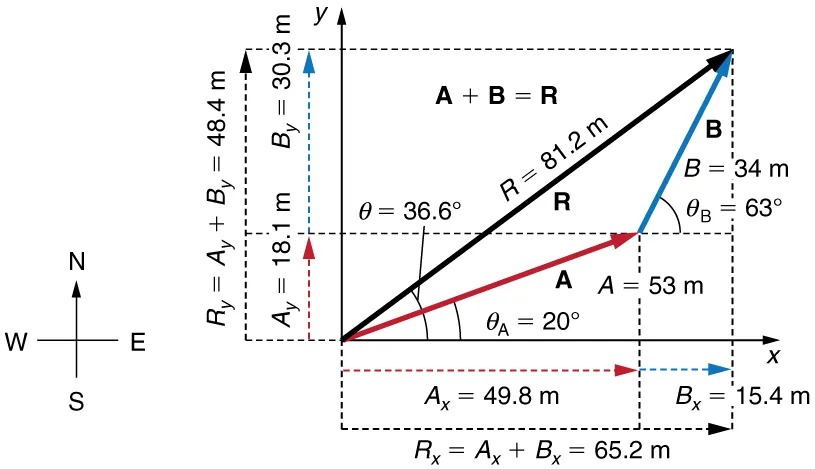
Figure 3.32 Using analytical methods, we see that the magnitude of [latex]\mathbf{R}[/latex] is [latex]\text{81} . \text{2 m}[/latex] and its direction is [latex]\text{36} . 6º[/latex] north of east. Image from OpenStax College Physics 2e, CC-BY 4.0
Image Description
The image is a vector diagram illustrating the addition of two vectors, A and B, to produce a resultant vector R on a two-dimensional plane with an x-y coordinate system.
– Vectors:
– A: Magnitude of 53 meters, forming an angle \( \theta_A = 20^\circ \) with the x-axis.
– B: Magnitude of 34 meters, forming an angle \( \theta_B = 63^\circ \) with the x-axis.
– R: Resultant vector, magnitude of 81.2 meters, forming an angle \( \theta = 36.6^\circ \) with the x-axis.
– Vector Components:
– A:
– Horizontal component \( A_x = 49.8 \) meters.
– Vertical component \( A_y = 18.1 \) meters.
– B:
– Horizontal component \( B_x = 15.4 \) meters.
– Vertical component \( B_y = 30.3 \) meters.
– R:
– Horizontal component \( R_x = A_x + B_x = 65.2 \) meters.
– Vertical component \( R_y = A_y + B_y = 48.4 \) meters.
– Coordinate System:
– A Cartesian coordinate system is shown with the x-axis pointing to the right and the y-axis pointing upwards.
– There’s also a reference to the cardinal directions: North (N), South (S), East (E), and West (W).
This diagram helps visualize how vectors can be broken down into their components and combined to form a resultant vector.
Discussion
This example illustrates the addition of vectors using perpendicular components. Vector subtraction using perpendicular components is very similar—it is just the addition of a negative vector.
Subtraction of vectors is accomplished by the addition of a negative vector. That is, [latex]\mathbf{A} - \mathbf{B} \equiv \mathbf{A} + \left(\right. \mathbf{–B} \left.\right)[/latex]. Thus, the method for the subtraction of vectors using perpendicular components is identical to that for addition. The components of [latex]–\textbf{B}[/latex] are the negatives of the components of [latex]\mathbf{B}[/latex]. The x– and y-components of the resultant [latex]\mathbf{A} - \text{B }=\text{ R}[/latex] are thus
[latex]R_{x} = A_{x} + \left(\right. – B_{x} \left.\right)[/latex]
and
[latex]R_{y} = A_{y} + \left(\right. – B_{y} \left.\right)[/latex]
and the rest of the method outlined above is identical to that for addition. (See Figure 3.33.)
Analyzing vectors using perpendicular components is very useful in many areas of physics, because perpendicular quantities are often independent of one another. The next module, 3.4 Projectile Motion, is one of many in which using perpendicular components helps make the picture clear and simplifies the physics.
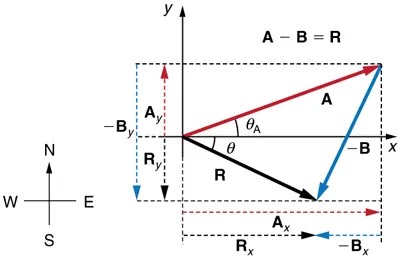
Figure 3.33 The subtraction of the two vectors shown in . The components of [latex]–\textbf{B}[/latex] are the negatives of the components of [latex]\mathbf{B}[/latex]. The method of subtraction is the same as that for addition. Image from OpenStax College Physics 2e, CC-BY 4.0
Image Description
The image is a diagram demonstrating vector subtraction and its components in a two-dimensional Cartesian coordinate system. The main axes are labeled x and y, with positive and negative directions clearly indicated.
There are three main vectors shown:
- A (red vector) directed from the origin with components Ax (horizontal component) and Ay (vertical component). The angle θA is the angle between vector A and its x-component.
- B (blue vector) directed downward and to the right with components Bx (horizontal component) and By (vertical component).
- R (black vector) represents the resultant of subtracting vector B from vector A, with components Rx and Ry.
The subtraction operation is expressed as A – B = R.
Each component has a corresponding line indicating its magnitude along the respective axis:
- Ax and Bx are horizontal components along the x-axis.
- Ay and By are vertical components along the y-axis.
- Rx and Ry represent the resultant’s components.
A compass rose is included to indicate directions with N (North), S (South), E (East), and W (West) marked.
PhET Explorations
Vector Addition
Learn how to add vectors. Drag vectors onto a graph, change their length and angle, and sum them together. The magnitude, angle, and components of each vector can be displayed in several formats.

